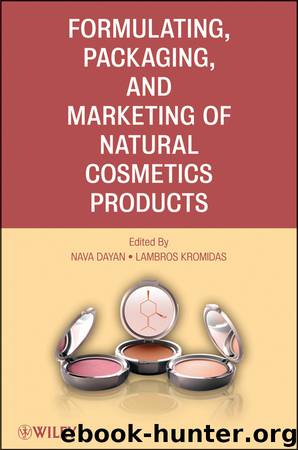Formulating, Packaging, and Marketing of Natural Cosmetic Products by Dayan Nava; Kromidas Lambros; & Lambros Kromidas

Author:Dayan, Nava; Kromidas, Lambros; & Lambros Kromidas
Language: eng
Format: epub
Publisher: Wiley
Published: 2011-06-09T16:00:00+00:00
11.9 Closures and Delivery Systems
Aside from applicators, probably the most critical packaging attribute that can significantly influence product exposure and play a major role in microbiological susceptibility is the design and functional nature of the package closure and delivery system. A closure that allows excessive product exposure to inadvertent microbial contamination whether from the environment or the consumer has the potential of being one of the major contributors to microbial risk and a significant threat to the safety and integrity of the total product system. Package configuration and closure design are the first line of defense in the protection of the product from microbial insult during normal conditions of storage and consumer use. Closures that are open in design and allow unrestricted access to the product optimize exposure conditions and set the stage for potential contamination incidents. An ideal package closure system would allow the product to be easily accessed, minimize overexposure to the environment, reduce or eliminate backflow and dripping during delivery, restrict or discourage direct contact with the delivery mechanism, be composed of recyclable or sustainable materials, and be presented in a stylish and user-friendly design (Table 11.11). Standard bottle closures essentially come in four basic designs, although newer, more progressive concepts are constantly coming on the scene. The most common conventional designs are the screw cap, the dispenser cap, the pump top, and the atomizer or spray top. Dispenser caps, which are normally used for both bottles and tubes, come in a fairly wide range of specialty configurations with orifices of various shapes and sizes. For cosmetic and personal care products such as shampoos, lotions, and creams, the most frequently used dispenser closures include the flip or snap cap with a circular orifice, the flip cap with a slit or slotted orifice, the flip spout dispenser cap, the disk top toggle-type dispenser cap, and the dropper tip cap. Most are constructed of plastics such as low-density polyethylene (LDPE), polypropylene, and other suitable petroleum-based plastic matrices. With the recent explosion of the green phenomenon, however, considerable interest is now being shown toward the development and possible use of more eco-friendly materials for standard closures and dispenser caps. In the case of bottles and other primary containers, some success has already been achieved using bioresins and similar natural or organically sourced materials. The adaptation of these same materials for closures, however, may not be as easily attainable considering some of the intrinsic material qualification attributes and functional design specifications required for closure composition. As advances are made, however, there is no question that the successful use of bioplastics and similar eco-friendly materials will eventually make its way into typical closure and delivery system applications.
Table 11.11 Ideal Closure.
Easily accessible
Minimizes product exposure
Reduces or eliminates backflow and dripping during delivery
Restricts or minimizes direct contact with delivery mechanism
Compatible with product and preservative system
Composed of recyclable or sustainable materials
Aesthetically appealing
In terms of potential microbial risk related to closure design, probably the most informative study and discussion on the subject to date was published by Brannan and Dille in 1990 [71].
Download
This site does not store any files on its server. We only index and link to content provided by other sites. Please contact the content providers to delete copyright contents if any and email us, we'll remove relevant links or contents immediately.
| Coatings, Ceramics & Glass | Cosmetics |
| Fluid Dynamics | Plant Design |
| Plastics | Unit Operations & Transport Phenomena |
Whiskies Galore by Ian Buxton(40292)
Introduction to Aircraft Design (Cambridge Aerospace Series) by John P. Fielding(32328)
Small Unmanned Fixed-wing Aircraft Design by Andrew J. Keane Andras Sobester James P. Scanlan & András Sóbester & James P. Scanlan(32135)
Craft Beer for the Homebrewer by Michael Agnew(17439)
Turbulence by E. J. Noyes(7031)
The Complete Stick Figure Physics Tutorials by Allen Sarah(6630)
Kaplan MCAT General Chemistry Review by Kaplan(6044)
The Thirst by Nesbo Jo(5777)
Bad Blood by John Carreyrou(5760)
Learning SQL by Alan Beaulieu(5398)
Weapons of Math Destruction by Cathy O'Neil(5027)
Man-made Catastrophes and Risk Information Concealment by Dmitry Chernov & Didier Sornette(4728)
iGen by Jean M. Twenge(4692)
Digital Minimalism by Cal Newport;(4509)
Life 3.0: Being Human in the Age of Artificial Intelligence by Tegmark Max(4492)
Audition by Ryu Murakami(4091)
1,001 ASVAB Practice Questions For Dummies by Powers Rod(4034)
Electronic Devices & Circuits by Jacob Millman & Christos C. Halkias(4019)
Pale Blue Dot by Carl Sagan(3995)
